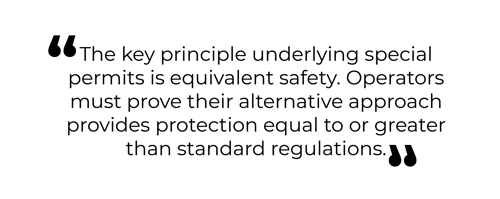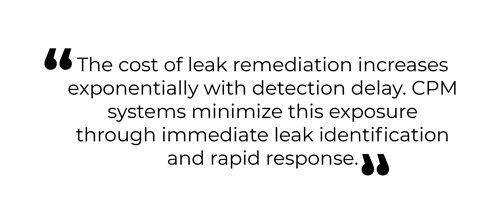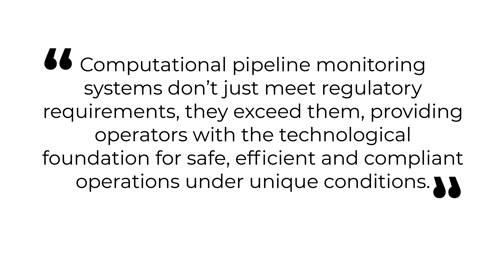Demonstrating pipeline safety and innovation through effective monitoring
Pipelines operating under non-standard conditions face unique regulatory challenges. Whether using composite materials, experiencing class location changes or implementing innovative designs, these operators often need more than standard regulatory compliance to ensure safe operations. This is where the Pipeline and Hazardous Materials Safety Administration’s (PHMSA) Special Permits become essential and where computational pipeline monitoring (CPM) leak detection systems prove their value. Business Development Director for gas Bob Truman goes into more detail in this blog about:
- Explaining PHMSA Special Permits
- The performance-based advantage of a special permit
- How CPM leak detection systems support special permit requirements
- Key applications for CPM in special permit scenarios
- Technical documentation requirements
- The strategic advantage of advanced CPM
- The cost-effectiveness of CPM leak detection systems
- Return on investment considerations
What is a PHMSA Special Permit?
A PHMSA Special Permit is a regulatory authorization that allows pipeline operators to deviate from specific federal pipeline safety regulations while maintaining equivalent or superior safety performance. Issued by PHMSA under the Department of Transportation (DOT), these permits  provide a pathway for operators to:1
provide a pathway for operators to:1
- Operate under unique conditions not directly addressed in standard regulations (49 CFR Parts 192 and 195)2,3
- Implement innovative technologies or construction methods that may not align with prescriptive regulatory requirements
- Adapt to changing circumstances such as class location changes or environmental considerations4
- Demonstrate alternative safety measures that achieve the same or better safety outcomes than standard compliance
The key principle underlying special permits is equivalent safety. Operators must prove their proposed alternative approach provides protection equal to or greater than what standard regulations would require.1
The performance-based advantage
PHMSA's regulatory framework is fundamentally performance-based rather than prescriptive.5 Instead of mandating specific technologies, regulations focus on achieving safety outcomes, particularly for critical functions like leak detection. This approach offers the following two significant advantages:
Technology flexibility
Operators can deploy any leak detection system capable of identifying all detectable leaks in their pipeline network, from traditional walking surveys to advanced computational monitoring systems.
Innovation incentives
The framework explicitly encourages development and deployment of novel technologies, creating opportunities to integrate:
- Real-time computational pipeline monitoring
- Advanced data analytics and machine learning6
- Integrated sensor networks and Internet of Things (IoT) devices
- Predictive maintenance algorithms
How computational pipeline monitoring leak detection systems support special permit requirements
Computational Pipeline Monitoring (CPM) leak detection systems represent a significant advancement over traditional leak detection methods. These systems provide real-time, 24/7 monitoring capabilities that directly address many special permit requirements:6
Real-time leak detection and response
Unlike periodic surveys, CPM systems provide continuous monitoring, enabling:
- Immediate leak identification when anomalies occur7
- Rapid response coordination to minimize incident consequences
- Continuous compliance demonstration rather than point-in-time snapshots
Enhanced sensitivity and coverage
CPM systems typically offer:
- Lower detection thresholds than traditional methods5
- Comprehensive pipeline coverage without geographical limitations
- Weather-independent operation ensuring consistent monitoring
Data-rich documentation
CPM systems generate extensive documentation that supports permit applications:
- Continuous operational data demonstrating system performance
- Historical trending showing long-term integrity management
- Automated reporting capabilities for regulatory compliance4
Key applications for CPM in special permit scenarios
Composite pipe installations
Special permits for composite pipelines often require enhanced integrity monitoring due to the newer technology and different failure modes compared to steel pipe. CPM leak detection systems address these requirements by:
- Providing continuous monitoring during the critical early operational period
- Detecting potential material degradation or joint failures
- Offering real-time validation of composite pipe performance
Class location changes
When population density increases around existing pipelines, triggering class location changes, PHMSA may require enhanced leak detection capabilities. CPM systems excel in these scenarios by providing:
- Increased monitoring sensitivity to detect smaller leaks that pose greater risk in populated areas
- Continuous coverage rather than periodic surveys with potential gaps
- Immediate alerting to minimize exposure time for nearby populations
- Detailed documentation of monitoring effectiveness in high consequence areas (HCAs)
Pressure anomaly management
For pipelines with complex pressure profiles or operating near Maximum Allowable Operating Pressure (MAOP), CPM systems provide:
- Real-time pressure and flow monitoring
- Correlation of pressure events with potential leak indicators
- Predictive analytics to identify developing integrity issues
Technical documentation requirements
Special permit applications require comprehensive technical justification.2 CPM systems strengthen applications across key areas, including:
System performance data
- Detection sensitivity specifications and test results
- Response time capabilities and alarm protocols
- Coverage area documentation and monitoring gaps analysis
Integration capabilities
- Compatibility with existing SCADA and pipeline management systems
- Data sharing protocols for emergency response coordination
- Maintenance and calibration procedures
Regulatory compliance features
- Automated reporting capabilities for PHMSA requirements4
- Data retention and audit trail functionality
- Performance metrics tracking and trending
The strategic advantage of advanced CPM
Modern CPM leak detection systems offer pipeline operators more than regulatory compliance. They provide a strategic advantage in special permit applications by demonstrating:
- Proactive safety management: continuous monitoring shows commitment to safety beyond minimum requirements
- Technological leadership: advanced systems demonstrate industry innovation and best practices
- Risk mitigation: real-time detection capabilities significantly reduce potential incident consequences8
- Operational efficiency: integrated monitoring reduces manual survey costs while improving detection reliability

The cost-effectiveness of CPM leak detection systems
Beyond safety and compliance benefits, CPM systems deliver compelling economic advantages that often justify their implementation purely from a financial perspective:
Reduced operating costs
Traditional leak detection relies on periodic walking surveys, aerial inspections or mobile surveys that require significant labor and equipment costs. CPM systems eliminate or drastically reduce these recurring expenses:
- Reduced crew deployment and associated travel costs
- Elimination of weather delays and rescheduling expenses
- Decreased equipment rental and maintenance for mobile detection units
Optimized inspection schedules
CPM enables risk-based inspection intervals rather than fixed schedules, allowing operators to focus resources where they're most needed while potentially extending intervals in low-risk areas.
Reduced inline inspection frequency
Traditional integrity management relies heavily on periodic inline inspections (ILIs) using intelligent pigs, which carry significant costs:9,10,11
- ILI runs typically cost $50,000-$200,000+ depending on pipeline length and complexity
- Required pipeline modifications for pig traps and launchers can cost hundreds of thousands of dollars
- Operational disruptions during pig runs result in lost throughput and revenue
- CPM systems provide continuous integrity monitoring between ILI runs, potentially allowing operators to extend ILI intervals from every 5-7 years to 7-10 years or longer, where regulations permit9
- Real-time leak detection capability complements ILI data by identifying active integrity issues immediately rather than waiting for the next scheduled inspection
Incident cost avoidance
Early detection value
The cost of leak remediation increases exponentially with detection delay. CPM systems minimize this exposure via:
- Smaller environmental cleanup costs through immediate leak identification
- Reduced product loss from faster response time
- Lower regulatory penalties associated with delayed incident reporting
- Minimized business interruption costs from shorter response and repair cycles
Liability reduction
Continuous monitoring demonstrates due diligence, potentially reducing liability exposure and insurance premiums in high-consequence areas.
Capital investment efficiency
Extended asset life
Real-time monitoring enables predictive maintenance strategies that can extend pipeline service life:10
- Early identification of developing integrity issues before they become critical
- Data-driven maintenance scheduling that prevents unnecessary interventions
- Optimized replacement planning based on actual condition rather than conservative timelines
Deferred capital expenditure
For class location changes, CPM systems may defer or eliminate the need for pipeline replacement by demonstrating adequate safety margins through enhanced monitoring.
Regulatory efficiency
Streamlined compliance
CPM systems often provide automated reporting and documentation, reducing administrative costs with:
- Automated generation of required leak detection reports12
- Simplified audit preparation with comprehensive data trails
- Reduced regulatory inspection preparation time
Faster permit approvals
Well-documented CPM capabilities can accelerate special permit review processes, reducing project delays and associated carrying costs.

Return on investment considerations
While initial CPM system costs vary based on pipeline length, complexity and chosen technology, operators can see positive returns within the first two years of operation through:
- Operational cost savings compared to traditional leak detection methods
- Incident avoidance that can exceed system costs in a single prevented event8
- Insurance premium reductions in some markets recognizing advanced monitoring
- Improved asset utilization through confidence in safe operating margins
Moving forward with CPM-enabled special permits
As pipeline infrastructure ages and operating environments become more complex, PHMSA Special Permits supported by advanced CPM leak detection systems represent the future of pipeline safety management. These systems don't just meet regulatory requirements, they exceed them, providing operators with the technological foundation needed for safe, efficient and compliant operations under unique conditions.
For operators considering special permit applications, investing in robust CPM leak detection systems early in the planning process can significantly strengthen their technical case while providing long-term operational benefits that extend far beyond regulatory compliance.
Discover how Atmos’ comprehensive suite of CPM leak detection products can support your special permit application and enhance your pipeline safety program
Atmos leak detection Contact us
References
3 https://www.ecfr.gov/current/title-49/subtitle-B/chapter-I/subchapter-D/part-192
4 https://www.phmsa.dot.gov/pipeline/class-location-special-permits/class-location-special-permits
5 https://primis.phmsa.dot.gov/comm/factsheets/fsleakdetectionsystems.htm
6 https://www.api.org/products-and-services/standards/important-standards-announcements/rp1130
7 https://standards.globalspec.com/std/14509506/rp-1130
8 https://www.rrc.texas.gov/media/g3blv1vv/leak-detection-cpm-alberto-hernandez.pdf
9 https://pmc.ncbi.nlm.nih.gov/articles/PMC6603558/
10 https://www.sciencedirect.com/science/article/abs/pii/S0308016124002874
11 https://inspenet.com/en/articulo/in-line-inspection-pipeline-evaluation/
12 https://www.scribd.com/document/181384749/ILI-Pipeline-Cost
